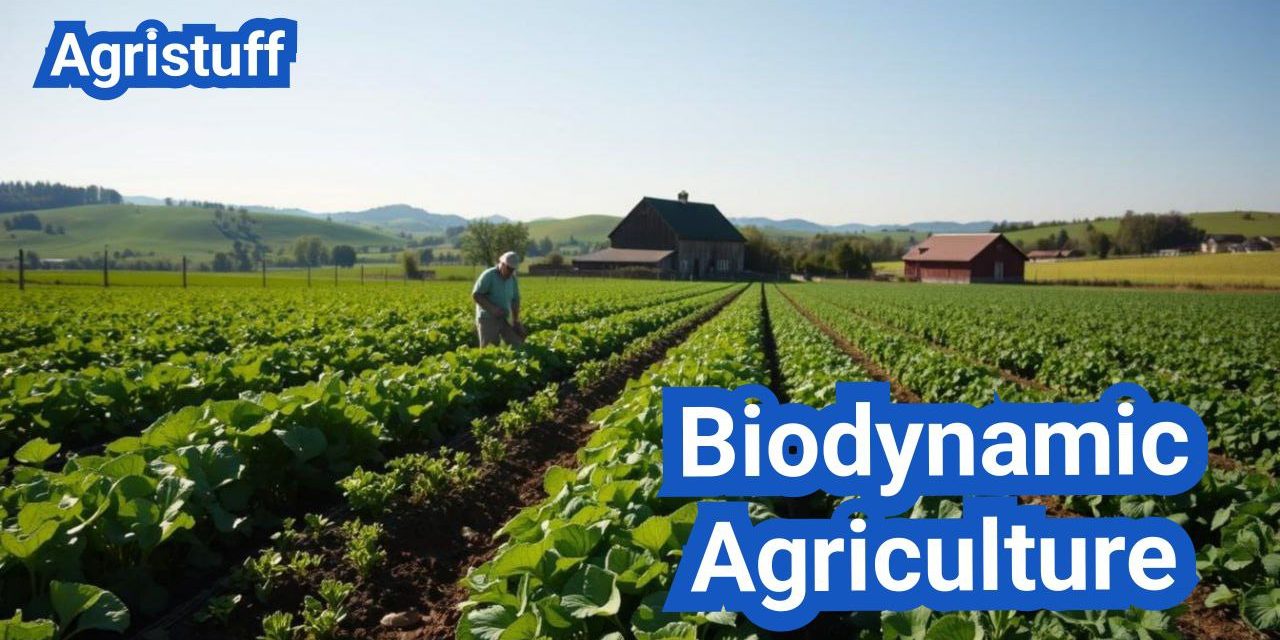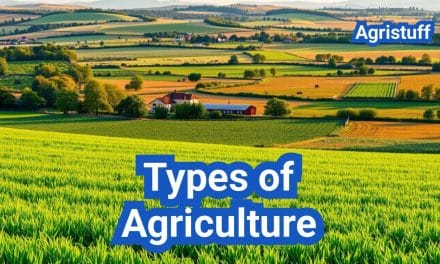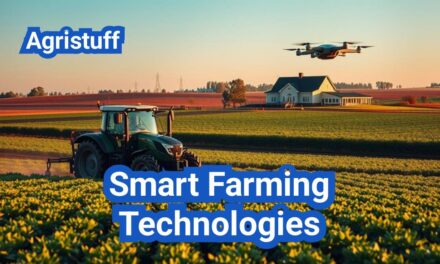Biodynamic agriculture is a regenerative approach that views the farm as a living organism, integrating ecological, ethical, and spiritual principles. Developed in the 1920s by Austrian philosopher Rudolf Steiner, this method emphasizes the interconnectedness of soil, plants, and animals.
This holistic farming practice focuses on ecological balance and regenerative practices, promoting biodiversity and soil health. By adopting biodynamic farming methods, farmers can improve the overall health of their farms, contributing to a more sustainable food system.
Key Takeaways
- Understanding biodynamic agriculture as a holistic approach.
- Recognizing the historical development by Rudolf Steiner.
- Identifying key principles such as ecological balance.
- Exploring the benefits of regenerative practices.
- Understanding the importance of biodiversity in biodynamic farming.
What is Biodynamic Agriculture?
The concept of biodynamic agriculture was pioneered by Rudolf Steiner in 1924, revolutionizing the way we think about farming. Biodynamic agriculture is a holistic approach that views the farm as a self-contained ecosystem, emphasizing the interrelation between soil fertility, plant growth, and livestock care.
Historical Origins and Development
Biodynamic agriculture was first developed in the early 20th century by Rudolf Steiner, an Austrian philosopher and scientist. Steiner’s work laid the foundation for a new approach to farming that integrated ecological and spiritual principles. The 1924 Agricultural Lectures by Steiner are considered the cornerstone of biodynamic agriculture, providing insights into the holistic management of farms.
The development of biodynamic agriculture was a response to the changing agricultural landscape of the time, which was increasingly influenced by chemical fertilizers and mechanization. Steiner’s approach offered an alternative that focused on the health of the soil, the vitality of plants, and the well-being of animals.
Core Philosophy and Worldview
At its core, biodynamic agriculture is based on a holistic worldview that sees the farm as an integrated organism. This approach emphasizes the importance of biodiversity, ecological balance, and the spiritual dimensions of farming. Biodynamic farmers strive to create a closed-loop system where waste is minimized, and resources are used efficiently.
- The farm is viewed as a living organism.
- Ecological and spiritual principles guide farming practices.
- Biodiversity and ecological balance are paramount.
By adopting biodynamic practices, farmers can enhance soil fertility, improve crop quality, and contribute to a more sustainable agricultural system. The principles of biodynamic agriculture offer a framework for farming that is not only environmentally friendly but also spiritually fulfilling.
Rudolf Steiner and the Birth of Biodynamics

In 1924, Rudolf Steiner delivered a series of agricultural lectures that would become the cornerstone of biodynamic farming. These lectures, given in response to a request from a group of farmers concerned about the future of agriculture, laid the groundwork for a holistic approach to farming that integrates the spiritual and material aspects of the natural world.
The 1924 Agricultural Lectures
Steiner’s 1924 lectures were pioneering, introducing the concept that the farm is a living organism with its own integrity. He emphasized the importance of understanding the farm as an interconnected system, where soil, plants, animals, and humans are not separate entities but parts of a whole. This perspective encourages farmers to adopt practices that enhance the overall health and biodiversity of the farm.
Anthroposophical Foundations
The principles of biodynamic agriculture are deeply rooted in anthroposophy, a philosophical framework developed by Steiner. Anthroposophy views the natural world as being imbued with spiritual forces that can be understood and worked with. In the context of farming, this means considering the influences of celestial bodies and the spiritual dimensions of soil, plants, and animals. By integrating these perspectives, biodynamic farmers can create farming systems that are not only productive but also regenerative and sustainable.
The anthroposophical foundations of biodynamics encourage a holistic understanding of the farm ecosystem, promoting practices that are in harmony with natural cycles and rhythms. This approach has inspired a global community of farmers and researchers who are working together to advance the principles of biodynamic agriculture.
Fundamental Principles of Biodynamic Agriculture
Biodynamic agriculture is guided by several fundamental principles that aim to enhance ecological balance and biodiversity. These principles form the backbone of biodynamic farming practices, distinguishing it from other agricultural methods.
Holistic Approach to Farming
A holistic approach is central to biodynamic agriculture, viewing the farm as a self-contained ecosystem where all elements are interconnected. This approach considers the farm as a living organism, where soil, plants, animals, and humans are integral parts of a delicate balance.
By adopting a holistic methodology, biodynamic farmers aim to create a sustainable and regenerative farming system that enhances biodiversity and promotes ecological health.
Integration of Cosmic and Terrestrial Forces
Biodynamic agriculture places significant emphasis on the integration of cosmic and terrestrial forces. This involves considering the influences of lunar cycles, planetary positions, and other celestial phenomena on farming practices.
By aligning farming activities with these natural rhythms, biodynamic farmers seek to optimize the growth and health of their crops, leveraging the subtle energies that flow from the cosmos to the earth.
Biodiversity and Ecological Balance
Biodiversity and ecological balance are crucial components of biodynamic agriculture. By fostering a diverse range of plant and animal species, biodynamic farms create resilient ecosystems that are better equipped to withstand pests, diseases, and environmental stresses.
This approach not only enhances the ecological integrity of the farm but also contributes to the production of high-quality, nutritious food.
Biodynamic vs. Organic Farming: Key Differences

While both biodynamic and organic farming reject the use of synthetic chemicals, their philosophies and practices diverge in significant ways. Biodynamic farming, founded by Rudolf Steiner, views the farm as a self-contained, living organism that integrates plants, animals, and humans in a holistic ecosystem.
Philosophical Distinctions
The primary philosophical difference between biodynamic and organic farming lies in their worldview. Biodynamic farming is deeply rooted in anthroposophical principles, which consider the farm to be a living entity influenced by celestial rhythms and forces. In contrast, organic farming focuses on the use of natural methods to maintain soil fertility and control pests and diseases without a specific spiritual or cosmic context.
Practical Differences in Methods
Biodynamic farming practices include:
- Using biodynamic preparations such as horn manure and horn silica to enhance soil and plant health.
- Following a biodynamic calendar that aligns farming activities with lunar and planetary cycles.
- Integrating livestock and crops in a closed-loop system to promote ecological balance.
In contrast, organic farming practices focus on:
- Avoiding the use of synthetic fertilizers and pesticides.
- Using compost and green manures to improve soil fertility.
- Implementing crop rotation and other conservation practices.
Certification Requirements Compared
Biodynamic farming is certified by Demeter, an international organization that sets strict standards for biodynamic practices. Demeter certification requires a detailed inspection of the farm to ensure compliance with biodynamic principles, including the use of biodynamic preparations and adherence to the biodynamic calendar.
Organic farming, on the other hand, is certified by various national and regional organizations, such as the USDA Organic in the United States. While organic certification standards vary, they generally focus on the avoidance of synthetic substances and the use of sustainable practices.
The key differences in certification requirements between biodynamic and organic farming lie in their scope and rigor. Biodynamic certification through Demeter is considered more comprehensive, as it encompasses not only the avoidance of synthetic inputs but also the integration of cosmic forces and the creation of a self-sustaining ecosystem.
The Biodynamic Method of Farming
The biodynamic method of farming is centered around creating a self-sustaining ecosystem that works in harmony with nature. This approach to agriculture emphasizes the importance of a closed-loop system where all elements of the farm are interconnected and interdependent.
Farm as a Closed-Loop System
In a biodynamic farm, the goal is to create a self-contained ecosystem that minimizes the need for external inputs. This is achieved by recycling waste, using compost, and integrating crops and livestock. By doing so, the farm becomes a thriving, diverse ecosystem that is resilient to environmental challenges.
Working with Natural Cycles
Biodynamic farming is deeply rooted in understanding and working with natural cycles. This includes lunar cycles, seasonal changes, and the rhythms of plant and animal life. By aligning farming practices with these natural cycles, farmers can enhance the health and productivity of their land.
Integration of Plants, Animals, and Humans
The integration of plants, animals, and humans is a cornerstone of biodynamic agriculture. This holistic approach recognizes that each component of the farm plays a vital role in the overall health of the ecosystem. For example, animals provide manure that is used to fertilize the soil, while crops are used to feed the animals.
| Component | Role in the Ecosystem | Benefits |
|---|---|---|
| Plants | Primary producers, soil stabilization | Crop diversity, soil health |
| Animals | Manure production, pest control | Fertilizer, ecosystem balance |
| Humans | Farm management, labor | Ecosystem stewardship, sustainable practices |
By adopting the biodynamic method of farming, farmers can create a more sustainable agricultural and regenerative agricultural system. This approach not only enhances biodiversity and ecosystem services but also contributes to the overall well-being of the farm and the surrounding environment.
Understanding the Biodynamic Preparations
Biodynamic preparations are specialized concoctions used in biodynamic farming to enhance soil fertility and plant health. These preparations are designed to work in harmony with the natural environment, promoting a balanced ecosystem within the farm.
Horn Manure (500) and Horn Silica (501)
Two of the most significant biodynamic preparations are Horn Manure (500) and Horn Silica (501). Horn Manure (500) is made by filling a cow horn with manure and burying it in the ground during the winter. This process allows the manure to decompose and develop beneficial microbial activity. In contrast, Horn Silica (501) is prepared by filling a cow horn with silica and burying it for several months. When applied, these preparations stimulate root growth and enhance plant vitality.
Compost Preparations (502-507)
The compost preparations, numbered 502 to 507, are a series of herbal preparations added to the compost pile to enhance its quality. These include yarrow, chamomile, nettle, oak bark, dandelion, and valerian. Each of these herbs contributes unique properties that promote a balanced compost ecosystem, ultimately leading to healthier soil.
| Preparation | Description | Benefit |
|---|---|---|
| 502 (Yarrow) | Made from yarrow flowers | Enhances potassium and sulfur availability |
| 503 (Chamomile) | Prepared from chamomile flowers | Promotes calcium and nitrogen balance |
| 504 (Nettle) | Made from nettle plants | Stimulates soil microbial activity |
| 505 (Oak Bark) | Derived from oak bark | Regulates soil calcium and prevents disease |
| 506 (Dandelion) | Prepared from dandelion flowers | Enhances soil silicon and promotes plant health |
| 507 (Valerian) | Made from valerian flowers | Stimulates phosphorus availability and plant growth |
Preparation 508 (Horsetail)
Preparation 508, also known as horsetail preparation, is made by brewing horsetail in water. This preparation is used as a spray to prevent fungal diseases in plants. It is particularly effective against mildew and other fungal infections, promoting overall plant health.
How to Make and Apply Biodynamic Preparations

The process of making and applying biodynamic preparations is a nuanced art that requires attention to detail and a deep understanding of natural cycles. Biodynamic preparations are specialized concoctions used to enhance soil quality, promote plant health, and foster a balanced ecosystem on biodynamic farms.
Materials and Equipment Needed
To make biodynamic preparations, farmers need specific materials and equipment. The primary preparations include horn manure (500), horn silica (501), and various compost preparations (502-507).
- Cow manure for horn manure (500)
- Quartz silica for horn silica (501)
- Various herbs and plants for compost preparations (502-507)
- Cow horns for containing the preparations
- Water for dilution and application
Step-by-Step Preparation Process
The preparation process involves several steps, including gathering materials, preparing the concoctions, and allowing them to mature.
- Gather the necessary materials, such as cow manure and quartz silica.
- Fill cow horns with the respective preparations and bury them in the ground.
- Allow the preparations to mature over the winter or summer months.
- Dig up the horns and extract the preparations for use.
Application Techniques and Timing
The application of biodynamic preparations requires careful consideration of timing and technique. Preparations are typically diluted in water and sprayed on fields or gardens.
| Preparation | Application Timing | Method |
|---|---|---|
| Horn Manure (500) | Evening, during the waning moon | Spray on soil |
| Horn Silica (501) | Early morning, during the waxing moon | Spray on plants |
| Compost Preparations (502-507) | During composting process | Mix into compost |
By following these guidelines and understanding the principles behind biodynamic preparations, farmers can enhance the health and productivity of their land, promoting a more sustainable and regenerative agricultural practice.
Working with the Biodynamic Calendar

The biodynamic calendar is a sophisticated tool that guides farmers in planning their agricultural activities in harmony with lunar and planetary influences. This ancient yet precise method helps farmers optimize their planting, cultivating, and harvesting schedules.
Understanding Lunar and Planetary Influences
The biodynamic calendar is based on the idea that celestial bodies exert subtle influences on plant growth and soil health. Lunar cycles, in particular, play a significant role in determining the optimal times for various agricultural activities.
Moon phases are closely observed, with the new moon and full moon being critical periods. The new moon is often considered ideal for sowing seeds, as it represents a time of renewal and growth. Conversely, the full moon is associated with heightened vitality and is considered beneficial for harvesting.
Planting, Cultivating, and Harvesting According to Cosmic Cycles
By aligning agricultural practices with the biodynamic calendar, farmers can potentially enhance crop yields and improve soil fertility. The calendar categorizes days into different types, such as root days, leaf days, flower days, and fruit days, each associated with specific planetary influences.
| Day Type | Planetary Influence | Agricultural Activity |
|---|---|---|
| Root Days | Saturation, grounding | Root crops, cultivation |
| Leaf Days | Expansion, growth | Leafy greens, pruning |
| Flower Days | Flowering, reproduction | Flowering plants, pollination support |
| Fruit Days | Fruiting, ripening | Fruiting plants, harvesting |
Practical Tools and Resources for Planning
To effectively utilize the biodynamic calendar, farmers can employ various tools and resources. Biodynamic calendars are published annually, providing detailed information on lunar and planetary positions. Additionally, mobile apps and software programs offer digital versions of the calendar, making it easier to plan agricultural activities.
By integrating the biodynamic calendar into their farming practices, farmers can cultivate a deeper connection with natural cycles and potentially improve the sustainability of their operations.
Soil Management in Biodynamic Farming

Soil management in biodynamic farming involves a holistic approach, integrating various techniques to enhance soil health and fertility. This approach is fundamental to creating a sustainable and productive farming system.
Building Soil Fertility Naturally
Building soil fertility is a cornerstone of biodynamic farming. This is achieved through natural methods that enhance the soil’s nutrient content and structure. Composting plays a crucial role in this process, as it involves breaking down organic matter to create a nutrient-rich soil amendment.
The use of organic amendments and the incorporation of cover crops also contribute to improving soil fertility. These practices help in maintaining soil health, reducing erosion, and supporting biodiversity.
Composting Methods
Composting is a vital practice in biodynamic farming, used to recycle organic waste into a valuable resource. The composting process involves decomposing organic materials under controlled conditions to produce a humus-rich product that enhances soil fertility and structure.
- Collecting organic waste materials
- Creating a compost pile with the right mix of ‘green’ and ‘brown’ materials
- Maintaining the compost pile through regular turning and monitoring
Biodynamic composting also involves the use of specific biodynamic preparations that are added to the compost pile to enhance its quality and effectiveness.
Green Manures and Cover Crops
Green manures and cover crops are integral to biodynamic soil management. These crops are grown to protect and enhance the soil, rather than for direct harvest. They help in suppressing weeds, improving soil structure, and increasing biodiversity.
Leguminous cover crops, such as clover and beans, are particularly valued for their ability to fix atmospheric nitrogen, thus enriching the soil’s nutrient content.
By incorporating green manures and cover crops into their rotation, biodynamic farmers can improve soil health, reduce the need for external inputs, and create a more resilient farming system.
Pest and Disease Management the Biodynamic Way

The biodynamic method of farming emphasizes the creation of balanced ecosystems to naturally mitigate pests and diseases. This approach diverges from conventional farming methods by focusing on the farm as a living organism.
Preventative Approaches
Preventative measures are crucial in biodynamic farming. These include crop rotation, maintaining soil health, and ensuring biodiversity. By rotating crops, farmers can break the life cycle of pests and reduce the risk of disease outbreaks.
Crop Rotation and Planning: Planning crop rotations that include a mix of crops can help in reducing pest and disease pressure. For example, planting legumes followed by cereals can enhance soil nitrogen and reduce the need for external inputs.
Natural Remedies and Controls
When preventative measures are not sufficient, biodynamic farmers employ natural remedies to control pests and diseases. These remedies include preparations made from plants and minerals.
Example of Natural Remedies: The use of neem oil derived from the seeds of the neem tree is a common practice. Neem oil acts as a natural insecticide and fungicide, helping to control a wide range of pests and diseases.
| Pest/Disease | Natural Remedy | Application Method |
|---|---|---|
| Aphids | Neem Oil | Spray on affected areas |
| Fungal Diseases | Copper-based Preparations | Spray on plants |
| Slugs and Snails | Crushed Eggshells | Barrier around plants |
Creating Balanced Ecosystems
Creating a balanced ecosystem is fundamental to biodynamic farming. This involves integrating crops, livestock, and beneficial organisms to create a resilient farm ecosystem.
By fostering biodiversity and ecological balance, biodynamic farmers can reduce their reliance on external inputs, including chemical pesticides and fertilizers. This not only improves the health of the farm ecosystem but also contributes to the well-being of consumers and the environment.
Implementing Biodynamic Practices at Different Scales

Whether you’re managing a small plot or a large farm, biodynamic principles can be successfully implemented. Biodynamic farming is a holistic approach that considers the farm as a living organism, integrating ecological, social, and economic aspects.
Home Gardens and Small Plots
Biodynamic practices are particularly well-suited for home gardens and small plots. These smaller areas can greatly benefit from the biodynamic approach, which emphasizes diversity and ecological balance. By using biodynamic preparations and following the biodynamic calendar, gardeners can enhance soil fertility and plant health.
In small gardens, it’s essential to create a diverse ecosystem. This can be achieved by planting a variety of crops, incorporating companion planting, and maintaining soil health through composting and mulching.
“The garden is a love song, a duet between a human being and Mother Nature.” – Jeff Cox
Medium-Sized Farms
Medium-sized farms can also reap the benefits of biodynamic practices. These farms often have more resources than small gardens but may still face challenges in terms of labor and equipment. Biodynamic methods can help improve soil fertility, reduce the need for external inputs, and promote ecological balance.
On medium-sized farms, integrating livestock into the farming system can be particularly beneficial. Animals can provide manure for compost, help control pests, and contribute to the overall biodiversity of the farm.
- Implement crop rotation and intercropping to enhance soil health and reduce pests and diseases.
- Use biodynamic preparations to stimulate soil biological activity and plant growth.
- Incorporate livestock to create a more diverse and resilient farming system.
Large-Scale Commercial Operations
Implementing biodynamic practices on large-scale commercial farms requires careful planning and management. These operations often involve extensive areas of monoculture crops, which can be challenging to convert to biodynamic methods.
However, many large farms are successfully transitioning to biodynamic practices. This involves adopting a more holistic approach to farming, integrating diverse crops and livestock, and using natural preparations to enhance soil and plant health.
| Scale | Key Considerations | Biodynamic Practices |
|---|---|---|
| Home Gardens | Diversity, soil health | Biodynamic preparations, companion planting |
| Medium-Sized Farms | Livestock integration, crop rotation | Composting, biodynamic calendar |
| Large-Scale Operations | Holistic planning, diverse crops | Natural preparations, ecological balance |
In conclusion, biodynamic practices can be effectively implemented at various scales, from small home gardens to large commercial farms. By adopting these methods, farmers and gardeners can promote ecological balance, improve soil health, and enhance biodiversity.
Regenerative Biodynamic Farming

The concept of regenerative biodynamic farming goes beyond mere sustainability, aiming to restore and improve the vitality of agricultural ecosystems. This approach integrates biodynamic principles with regenerative practices to enhance soil health, biodiversity, and ecological balance.
Beyond Sustainability to Regeneration
Regenerative biodynamic farming is not just about maintaining the status quo but actively improving the health of the farm ecosystem. It involves a holistic approach that considers the farm as an interconnected system where soil, plants, animals, and humans are interdependent.
Key practices include minimizing external inputs, enhancing soil fertility through natural means, and promoting biodiversity. By adopting these practices, farmers can improve the resilience of their farms and contribute to a healthier environment.
Carbon Sequestration and Climate Benefits
One of the significant benefits of regenerative biodynamic farming is its potential for carbon sequestration. By enhancing soil health and promoting the use of cover crops and organic amendments, farmers can help remove carbon dioxide from the atmosphere, thus mitigating climate change.
Studies have shown that regenerative agriculture can lead to significant reductions in greenhouse gas emissions. For instance, a study on regenerative farming practices found that they can reduce emissions by up to 70% compared to conventional farming methods.
Success Stories and Case Studies
Several farms around the world have successfully implemented regenerative biodynamic farming practices, achieving remarkable results. For example, a farm in the United States was able to increase its soil organic matter by 30% within three years of adopting regenerative practices.
These success stories demonstrate the potential of regenerative biodynamic farming to transform agricultural landscapes and contribute to a more sustainable future.
Demeter Certification: Standards and Process

Demeter certification is a rigorous process that ensures biodynamic farms meet the highest ecological and ethical standards. This certification is crucial for farmers who wish to validate their commitment to biodynamic farming practices.
Certification Requirements
To achieve Demeter certification, farms must adhere to a set of strict guidelines that cover various aspects of biodynamic farming. These include:
- Maintaining soil fertility through natural means
- Promoting biodiversity on the farm
- Using biodynamic preparations to enhance soil and plant health
- Following the biodynamic calendar for planting and harvesting
Inspection and Compliance: Farms undergo regular inspections to ensure compliance with Demeter standards. This includes a thorough review of farming practices, record-keeping, and the overall condition of the farm.
Steps to Achieve Certification
The process of achieving Demeter certification involves several steps:
- Application: Farmers submit an application to a Demeter certification body.
- Inspection: A Demeter inspector visits the farm to assess compliance with the standards.
- Review: The certification body reviews the inspection report and application.
- Certification: If the farm meets all requirements, Demeter certification is granted.
It’s a rigorous process that ensures only farms committed to biodynamic principles are certified.
Maintaining Certified Status
To maintain Demeter certification, farms must continue to adhere to the standards and undergo regular inspections. This includes:
- Annual inspections to ensure ongoing compliance
- Updating records and practices as per Demeter guidelines
- Participating in continuing education related to biodynamic farming
By maintaining Demeter certification, farmers not only ensure the integrity of their biodynamic produce but also contribute to the global standards of biodynamic farming.
Benefits and Examples of Biodynamic Agriculture
The benefits of biodynamic agriculture are multifaceted, ranging from environmental sustainability to enhanced nutritional quality. Biodynamic farming practices not only promote ecological balance but also contribute to the production of high-quality, nutritious food.
Environmental Advantages
Biodynamic agriculture offers several environmental benefits, including improved soil fertility, biodiversity conservation, and efficient water use. By adopting a holistic approach to farming, biodynamic farmers can enhance ecosystem services and reduce their environmental footprint.
Key environmental advantages include:
- Soil conservation and regeneration
- Biodiversity enhancement
- Efficient water management
- Reduced chemical usage
| Environmental Benefit | Description | Impact |
|---|---|---|
| Soil Conservation | Use of natural methods to enhance soil health | Improved fertility and structure |
| Biodiversity Enhancement | Promotion of diverse ecosystems | Increased ecological balance |
| Efficient Water Management | Use of techniques like mulching and cover cropping | Reduced water consumption |
Quality and Nutritional Benefits
Biodynamic farming is known for producing high-quality, nutritious food. The emphasis on natural soil fertility, biodiversity, and minimal external inputs results in crops that are rich in nutrients and flavor.
Nutritional benefits include:
- Higher nutrient content in crops
- Improved flavor and texture
- Potential health benefits from consuming biodynamic produce
Successful Biodynamic Farms Worldwide
There are numerous examples of successful biodynamic farms around the world. These farms demonstrate the potential of biodynamic agriculture to promote sustainability and produce high-quality food.
Notable examples include:
- Loose More Farm in the UK, known for its biodynamic vegetable production
- Tarango Homestead in Australia, which integrates biodynamic farming with conservation efforts
- Windy Hill Farm in the USA, a pioneer in biodynamic dairy farming
The Future of Biodynamic Agriculture
Biodynamic agriculture has emerged as a holistic approach to farming, integrating cosmic and terrestrial forces to create a balanced ecosystem. By adopting biodynamic practices, farmers can contribute significantly to sustainable and regenerative agriculture, shaping the future of food production.
The principles of biodynamic farming, as outlined by Rudolf Steiner, emphasize the importance of working with natural cycles and treating the farm as a closed-loop system. This approach not only enhances soil fertility and biodiversity but also promotes ecological balance, leading to more resilient farming systems.
As the world grapples with the challenges of climate change, environmental degradation, and food security, biodynamic agriculture offers a promising solution. By embracing regenerative agriculture practices, farmers can improve carbon sequestration, reduce synthetic inputs, and promote sustainable farming methods.
The future of biodynamic agriculture looks bright, with increasing adoption rates and growing demand for sustainably produced food. As more farmers and consumers become aware of the benefits of biodynamic farming, it is likely to play an increasingly important role in shaping the future of agriculture, contributing to a more sustainable food system for generations to come.
FAQ
What is biodynamic farming?
Biodynamic farming is a holistic and sustainable approach to agriculture that views the farm as a living organism, integrating ecological and spiritual principles to promote biodiversity and ecological balance.
Who developed biodynamic agriculture?
Biodynamic agriculture was developed by Rudolf Steiner, an Austrian philosopher, in the early 20th century, based on his agricultural lectures in 1924.
What are the core principles of biodynamic agriculture?
The core principles of biodynamic agriculture include a holistic approach to farming, integration of cosmic and terrestrial forces, biodiversity, and ecological balance, aiming to create a self-sustaining ecosystem.
How does biodynamic farming differ from organic farming?
Biodynamic farming differs from organic farming in its emphasis on spiritual and cosmic principles, the use of biodynamic preparations, and a more holistic approach to farm management, whereas organic farming focuses on avoiding synthetic inputs.
What are biodynamic preparations?
Biodynamic preparations are a set of natural substances, such as horn manure and horn silica, used to enhance soil fertility, plant health, and biodiversity, made according to specific methods and applied in minute quantities.
How do biodynamic farmers manage soil fertility?
Biodynamic farmers manage soil fertility through natural methods, including composting, green manures, and cover crops, to build soil health and promote biodiversity.
What is the biodynamic calendar?
The biodynamic calendar is a tool used to plan agricultural activities according to lunar and planetary influences, helping farmers to optimize planting, cultivating, and harvesting based on cosmic cycles.
How can biodynamic practices be implemented at different scales?
Biodynamic practices can be implemented at various scales, from small home gardens to large commercial farms, by adapting the principles and methods to the specific context and needs.
What is Demeter certification?
Demeter certification is a standard for biodynamic farming that ensures the integrity of biodynamic practices, requiring farms to meet specific requirements and undergo regular inspections to maintain certified status.
What are the benefits of biodynamic agriculture?
The benefits of biodynamic agriculture include environmental advantages, such as biodiversity and soil health, as well as quality and nutritional benefits for consumers, promoting a more sustainable food system
Can biodynamic farming help mitigate climate change?
Yes, biodynamic farming, particularly regenerative biodynamic farming, can help mitigate climate change by sequestering carbon, promoting soil health, and reducing the reliance on external inputs.
How can I get started with biodynamic gardening?
To get started with biodynamic gardening, begin by understanding the core principles, preparing the soil with natural methods, and using biodynamic preparations, while working with the biodynamic calendar to plan your activities.
Conclusion of: Biodynamic Agriculture
Biodynamic agriculture is gaining recognition as a holistic and sustainable farming method that goes beyond traditional organic practices. Rooted in the spiritual-scientific teachings of Rudolf Steiner from the 1920s, it views the farm as a self-sufficient organism that harmonizes soil, plants, animals, and cosmic rhythms. The term “biodynamic agriculture” appears early in this piece to align with SEO best practices.
What Is Biodynamic Agriculture?
In its essence, biodynamic agriculture is a planetary-aware and integrative farming system that treats the farm as a living whole—comprising fields, forests, plants, animals, soil, compost, humans, and even spirit, all interacting harmoniously biodynamics.com. Using only on-farm fertility—via compost, crop rotations, cover crops, and livestock integration—this approach minimizes external nutrient imports and emphasizes ecological balance biodynamics.com. Farmers also align activities like planting and harvesting with lunar and astrological cycles, believing these cosmic forces enhance farm vitality reddit.com+2kisstheground.com+2biodynamics.com+2.
External link: Biodynamic Association – Principles & Practices
Origins and Philosophy Behind Biodynamic Agriculture
Biodynamic agriculture originated from a series of lectures by Austrian philosopher Rudolf Steiner in 1924. Concerned about soil degradation, Steiner introduced the concept of an “Experimental Circle,” combining scientific inquiry with spiritual awareness to guide farming foodandwine.com+14biodynamics.com+14biodynamics.com+14. His teachings grew into a movement merging anthroposophy—knowledge of the spiritual world—with ecological stewardship.
External link: Wikipedia – Biodynamic Agriculture
Core Principles of Biodynamic Agriculture
The backbone of biodynamic agriculture rests on a few key principles:
- Holistic Farm as Organism – Treating farm components as interdependent masterclass.com+1en.wikipedia.org+1masterclass.com+15ranchoalmasomos.com+15en.wikipedia.org+15biodynamics.com+1jurlique.com+1.
- On-Farm Fertility – Creating nutrient cycles with compost, animals, rotations, and cover cropping biodynamics.com+1kisstheground.com+1.
- Biodiversity – Maintaining plant, animal, microbial, and insect diversity for system health .
- Cosmic Rhythms – Timing actions by moon, astrological, and planetary phases .
- Preparations – Applying specially crafted herbal and mineral compost sprays to boost soil and plant strength rovensanext.com.
External link: NC State Extension – Biodynamic Overview
Biodynamic Preparations: What Makes Them Unique
In biodynamic agriculture, preparations like horn manure (Preparation 500) and silica spray (Preparation 501) are used. Horns are buried with manure over winter, then exhumed, diluted in water, and sprayed to stimulate soil life and growth cycles biodynamics.com+9horticulture.ces.ncsu.edu+9ranchoalmasomos.com+9demeter.net. Compost preparations combining herbs such as yarrow and stinging nettle bolster microbial biodiversity and improve nutrient bioavailability .
External link: Demeter International – Biodynamic Research
Biodynamic vs. Organic Agriculture
While biodynamic agriculture shares many practices with organic farming—no synthetic chemicals, emphasis on soil health, compost, biodiversity—it also incorporates cosmic awareness and mysticism rovensanext.com+5horticulture.ces.ncsu.edu+5demeter.net+5. NC State describes it as “beyond organic” horticulture.ces.ncsu.edu, while skeptics argue that many benefits might come from standard organic practices, not necessarily the spiritual additions .
External link: The Myth of Biodynamic Agriculture – WSU
Scientific Evidence and Research in Biodynamic Agriculture
The research base for biodynamic agriculture is still developing. Meta-analyses and systematic reviews (e.g. Brock et al. 2019, Santoni et al. 2022) indicate improved soil microbial activity and fertility compared to conventional systems wpcdn.web.wsu.edu+1it.wikipedia.org+1demeter.net. Long-term trials show deeper root systems, greater earthworm presence, and lower emissions than organic counterparts kisstheground.com. However, studies caution that isolating the effects of cosmic-based preparations from other organic practices can be difficult horticulture.ces.ncsu.edu+6it.wikipedia.org+6demeter-usa.org+6.
External link: Kiss the Ground – Biodynamic Farming Guide
Certification: Demeter and Quality Assurance
To market as biodynamic agriculture, farms must be certified by the Demeter organization, founded in 1928 and active across 65+ countries rovensanext.com+15en.wikipedia.org+15kisstheground.com+15. Standards include biodiversity quotas, on-farm fertility systems, and full traceability from field to shelf, with certification renewal required annually . Demeter-labeled products typically fetch a 10–30% price premium in markets .
External link: Demeter International – Certification Info
Biodynamic Agriculture in the USA
In the U.S., biodynamic agriculture is gaining traction, especially among vineyards and small-scale diversified farms en.wikipedia.org+1demeter.net+1. While still a niche compared to organic farming, more farmers are seeking Demeter certification. U.S.-based studies have indicated that biodynamic grapes show comparable soil health and yields to organic ones, though sensory quality sometimes scores higher in tastings .
External link: NC State Extension – U.S. Biodynamics
Benefits of Biodynamic Agriculture
Adopting biodynamic agriculture can yield a range of benefits:
- Enhanced Soil Health: Higher organic matter, microbial diversity, earthworms horticulture.ces.ncsu.edukisstheground.com+1arxiv.org+1.
- Plant Vitality: Improved root systems, nutrient uptake, stress resilience .
- Biodiversity Gains: More birds, insects, and wildlife due to habitat emphasis .
- Market Differentiation: Premium pricing via Demeter label .
- Lower External Inputs: Reduced dependence on purchased fertilizers and chemicals.
External link: Kiss the Ground – Soil Benefits
Criticisms and Controversies
Despite its benefits, biodynamic agriculture faces criticisms:
- Pseudo‑scientific elements: Critics view cosmic and spiritual components as untestable or mystical .
- Research limitations: Many studies do not isolate biodynamic methods from general organic ones .
- Cost & Labor: Preparations and certification are labor-intensive and potentially expensive .
- Scaling challenges: Less suitable for large monocultures where mechanization dominates .
Despite this, ongoing studies continue investigating microbial, soil, and ecological outcomes .
External link: Rovensa Next – Biodynamic Science & Debate
Biodynamic Agriculture in Practice: Examples from Farms
Real‑world examples of biodynamic agriculture include:
- Viticulture: Leading wineries in France, Chile, the U.S., and Australia use biodynamic methods, enhancing terroir expression via holistic soil and plant care rovensanext.comen.wikipedia.org.
- Diversified Farms: Farms integrate crops, livestock, orchards, and cover crops in mutual cycles.
- Herbal & Medicinal Gardens: Growers use biodynamic timing and sprays to maximize plant vitality kisstheground.com+3ranchoalmasomos.com+3biodynamics.com+3horticulture.ces.ncsu.edu.
External link: Food & Wine – Biodynamic Wine Explained
Getting Started with Biodynamic Agriculture
Farmers curious about biodynamic agriculture can begin by:
- Building coherent farm ecosystems around compost, rotations, and livestock.
- Learning and applying Demeter-approved herbal preparations.
- Following the biodynamic planting calendar.
- Seeking guidance from organizations like Demeter USA and Biodynamic Association ranchoalmasomos.com+4foodandwine.com+4youtube.com+4en.wikipedia.orghorticulture.ces.ncsu.edu+4biodynamics.com+4demeter-usa.org+4.
- Considering Demeter certification if selling produce.
This gradual approach allows farmers to evaluate impacts on soil health, biodiversity, and economic viability.
External link: Biodynamic Association – Member Resources
Future Directions for Biodynamic Agriculture
Looking ahead, biodynamic agriculture may evolve alongside regenerative and precision farming. Soil microbiome research and AI tools for soil carbon monitoring could validate biodynamic approaches and help integrate them into broader sustainability frameworks biodynamics.com. Potential integration with regenerative carbon farming could enhance biodiversity and sequester carbon at scale.
Yet reproducible, economically viable models are needed. Continued studies isolating biodynamic practices from organic controls can strengthen scientific confidence.
External link: arXiv – Soil Carbon in Regenerative Agriculture
Final thought
Biodynamic agriculture offers a rich, holistic, and spiritually rooted approach to farming that emphasizes soil vitality, ecological balance, and cosmic harmony. While some practices remain controversial or difficult to validate scientifically, strong evidence supports its soil, biodiversity, and health benefits—particularly when combined with organic systems. With growing consumer interest and supportive research, biodynamics is maturing from niche philosophy toward practical regenerative agriculture. Whether you’re a grower, gardener, or eco‑enthusiast, integrating biodynamic principles may foster resilience, quality, and ecological harmony in your land.










